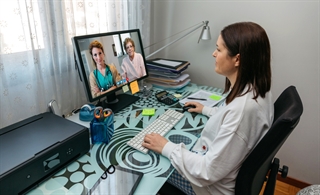MDS Community Conversations: Telemedicine Personal Experiences

MDS Community Conversations Advisory Team: Victor Fung, MBBS, PhD, FRACP; Kelvin Chou, MD, FAAN; Maria Stamelou, MD, PhD, FEAN; Catalina Cerquera-Cleves, MD; Oluwadamilola Ojo, MD; Woong-Woo Lee, MD
Prepared by Catalina Cerquera-Cleves, MD & Sarah Wahlstrom Helgren, PhD
The global pandemic has made telemedicine more relevant than ever. In this post, movement disorders specialist from around the world share their personal experiences with telemedicine. As the pandemic crisis continues, we hope these experiences can provide insight and encouragement to other professionals utilizing telehealth.
Please note, the MDS Telemedicine Study Group has been very active and provided a Step-by-Step Telemedicine Guide in addition to regional information about local telemedicine regulations.
Highlights from the responses we gathered:
- Most movement disorders specialists interviewed used telemedicine to some greater or lesser extent during the pandemic, even though most of them did not have had previous experience with this tool. Phone calls, videoconferences, emails, and SMS/text messages were some of the options used.
- They all considered telemedicine does not replace in-person visits; however, they believed it was a useful tool for following some patients during the pandemic.
- Many in-person visits remained during the epidemic in most centers, especially those who involved new patients, DBS programming, and botulinum toxin injections.
- While many patients were reluctant to use telemedicine initially, then most got used to it over time. Still, some of them also preferred to continue with the virtual follow-up, even after the re-opening, especially those who live a considerable distance from the clinic. Currently, several centers still do some telemedicine visits, although to a lesser extent.
- Internet connectivity, technical problems, wifi-access limitations, social conditions, legal issues, physical limitations, age and patient's cognitive state, and a lack of caregiver or family support were some of the main barriers to telemedicine. Some patients also feel that virtual visits do not provide the same personal experience they are used to with doctors' visits.
Recommendations and advice from the responses:
- Recognize that this tool is useful for specific patients and is not feasible in all clinical scenarios, probably it will be more helpful in follow-up visits and for people with a certain educational and social level
- Set realistic expectations regarding quality of the visit, what can be achieved during the visit, and the amount of time you will do visits, this will save time and resources
- To avoid disruptions, log out of idle/unnecessary programs especially in areas/regions with limited bandwidth.
- Try to group all telemedicine visits in one clinic session
- Do not give up when some problems arise. Your investment will be worth the time.
In their own words, here are some of the responses we received:
 Kelvin L. Chou, MD
Kelvin L. Chou, MD
University of Michigan, Ann Arbor, MI, USA
Clinic Description: My clinic is part of an academic tertiary care center
“For a few months earlier this year, I switched to 100% telemedicine. Now that our clinics have opened up, I am doing around 25% telemedicine. I like doing it, as it adds some variety to my day. Once my patients did a video visit, they were much more interested in continuing with it, especially those who lived a considerable distance from our clinic. I think telemedicine will be an important part of our patient care in the future once patients become used to it.”
 Esther Cubo MD, PhD
Esther Cubo MD, PhD
Hospital Universitario de Burgos, Burgos, Spain
What is the biggest barrier to telemedicine for your patients: “legal barriers”
 Oluwadamilola Ojo MBBS, FMCP
Oluwadamilola Ojo MBBS, FMCP
Lagos University Teaching Hospital, Lagos, Nigeria
Clinic Description: The Lagos Movement Disorders Clinic is in southwest Nigeria, holds once a week. Prior to the pandemic-induced lockdown, we had ~ 15-17 patients weekly. Since reopening the clinic we see ~6-8 patients in-person weekly. In total, ~ 450 patients.
“Prior to the epidemic, I had limited experience with telemedicine (mainly patients who have my personal phone line requesting professional advice in-between visits and for follow-up of post-chemodenervation patients from out of town/state). During the pandemic, some patients expressed an interest in telemedicine/ being seen remotely. The movement disorders clinic in my institution (like other specialist clinics) received a dedicated communication track composed of a central online form which was forwarded to the clinic/consultant in charge. Other patients contacted the clinic dedicated phone line directly (new option for patients during the pandemic). Most patients in private settings did request and preferred telemedicine via video-enabled apps like Zoom. Yes, telemedicine worked during the lockdown and is still working during the phased re-opening for patients who would rather not come to the hospital.”
What is the biggest barrier to telemedicine for your patients: “Barriers to telemedicine include cost of data/internet service, cost of smart phones (most have phones with basis call and sms functions), remote areas with poor ISP coverage/internet connectivity (though these can be seen in an asynchronous manner).”
 Catalina Cerquera-Cleves MD, MSc
Catalina Cerquera-Cleves MD, MSc
Pontificia Universidad Javeriana, Hospital San Ignacio, Clinica Colombia
Clinic Description: I work in two different university hospitals in Bogota, Colombia.
“Before the pandemic, we were not adequately supplied with resources to deal with telemedicine's needs that our patients required. That is why we had to move fast and acquire all tools to connect with our patients in the way they needed it. In that way, we could attend at least 60-70% of our patients by telemedicine, especially those that we already knew and required monitoring, assuring to continue with an appropriate follow-up and treatment. The disadvantages of telemedicine in our setting were related to connectivity issues of some patients that limited good quality communication or difficulties in handling the tools and apps to get connected. Thus, in some cases, we finally had to use phone calls to communicate with them instead of videocalls. For this reason, most of the first-time visits continued to be in-person since it was the only way to guarantee an adequate clinical examination at a first medical appointment in Movement Disorders. Even though telemedicine did not replace conventional in-person visits, we could provide proper healthcare in an uncertain scenario of a pandemic. Most of the patients reported feeling safer while being attending through that kind of assessment.”
 Zoltan Mari, FAAN, MD
Zoltan Mari, FAAN, MD
Cleveland Clinic Lour Ruvo Center for Brain Health, Las Vegas, NV, USA
Clinic Description: We are part of greater Cleveland Clinic, in Las Vegas, NV, a neurology single specialty practice and research center.
“Our Center markedly increased our virtual visit numbers overall, however, not proportionally among providers. Within the movement disorders team, we have two MDs and two NPs. The NPs have been granted the privilege of working mostly from home to do virtual visits, to minimize their exposure to in-person care. Therefore, they mostly see routine follow-up visits. The MDs on the other hand disproportionately do more of the visits that require in-person care, such as new patients, DBS programming, and BoNT injections.”
What is the biggest barrier to telemedicine for your patients: “Mostly just psychological resistance to technology and anything new and some feel that virtual visits do not provide the same personal experience they are used to with doctors' visits.”
 Emilia M Gatto, MD, FAAN
Emilia M Gatto, MD, FAAN
Instituto de Neurociencias Buenos Aires (INEBA), Buenos Aires, Argentina
Clinic Description: Affiliated Institution to Facultad de Medicine, University of Buenos Aires, Ciudad de Buenos Aires, Argentina
“Telemedicine has been a useful tool during the pandemic; it was my first experience in this field. Although useful, these methods are not sufficient to replace the in-person evaluation. Furthermore, at the beginning in our country there was no policy on telemedicine, including legal protection for doctors. I will continue telemedicine for some patients who live in other areas or cities.”
Woong-Woo Lee, MD
Nowon Eulji Medical Center, Eulji University, Seoul, South Korea
Clinic Description: I am working as a movement specialist in an academic referral hospital located in Seoul. I have a special clinic for Parkinson's disease.
What is the biggest barrier to telemedicine for your patients: “My patients are not used to use electrical devices because most of them are aged.”
Continue the conversation on:
Facebook, Twitter and Linkedin






